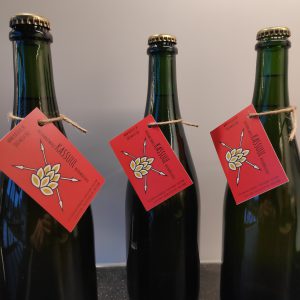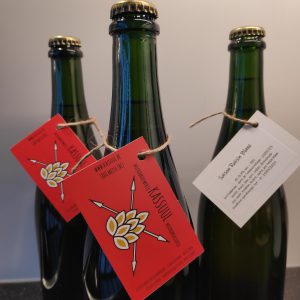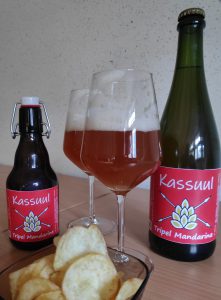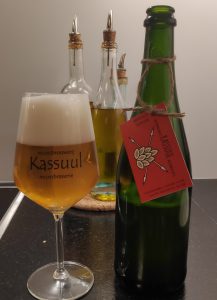Dit jaar hebben voor het eerst eigen hop aangeplant. In het voorjaar werden zes hopplanten vakkundig geplant. We hebben gekozen voor de soorten Mandarina Bavaria, Cascade en Hallertau Blanc.
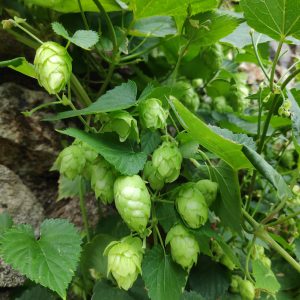
Cascade kennen we sedert 1972. Het is de meest gebruikte hop in de Amerikaanse Craftbeer wereld. Met zijn aroma’s van dennen-, citrus- en bloemige ondertonen geeft deze aan het brouwsel leven en persoonlijkheid. Met een gematigd alfaniveau (bepalend voor de bitterheid) kan deze hop veelzijdigheid gebruikt worden, dus zowel als aromahop maar ook als bitterhop.
Mandarina Bavaria werd gekweekt in 2012 uit een kruising van Cascade en Hüll en heeft als kenmerk dat het een (zoals de naam ook zegt) aroma heeft van zoete sinaasappel-citrussmaak die doet denken aan mandarijnen en clementines. Aromatisch met een bescheiden bitterheid, kan Mandarina Bavaria-hop als enige hop gebruikt worden (zoals ik het meestal doe), of sterke oranje citrustonen toevoegen aan hopmengsels.
Hallertau Blanc werd voor het eerst geteeld in 2012 (regio Hallertau in Duitsland). Deze fruitige aromahop, met wijnachtige eigenschappen van kruisbes en grassige toetsen, is vergelijkbaar met deze van de wijndruif Sauvignon Blanc. Zij beschikt ook over een complex aromaprofiel met tonen van cassis en vlierbloesem, naast druiven, grapefruit en citroengras. Andere tonen die tijdens het proeven ontdekt kunnen worden zijn passievrucht en ananas. Een heel fijne hop om een Saison bier mee op smaak te brengen.
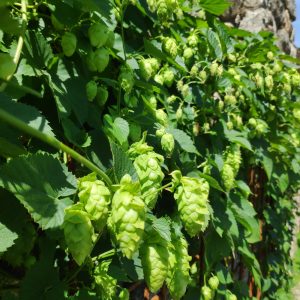
Dit eerste jaar hebben we toch al heel wat hop kunnen oogsten. De vers geplukte hop moet zo snel mogelijk gedroogd worden zodat de lupuline (de smaakstof waarom hop geteeld wordt) maximaal zijn aroma behoudt. Dit doen we gedurende vier uur bij 45°C in een voedseldroger. Verse hop bevat ongeveer 70 tot 80% water. Hierdoor houd je dus van 100 gr. verse hop nog ongeveer 20 tot 25 gr. gedroogde hop over. Uiteindelijk hebben we op deze manier 400 gr. hop kunnen vacuüm verpakken en bewaren we ze nu in de diepvriezer. Dit in afwachting van het moment dat zij als aromahop in één van de volgende brouwsels terecht komen.
Cette année, nous avons planté notre propre houblon pour la première fois. Six plants de houblon ont été savamment plantés au printemps. Nous avons choisi les variétés Mandarina Bavaria, Cascade et Hallertau Blanc.
Nous connaissons Cascade depuis 1972. C’est le houblon le plus utilisé dans le monde de la bière artisanale américaine. Avec ses arômes de pin, d’agrumes et de nuances florales, il donne vie et personnalité au breuvage. Avec un niveau alpha modéré (déterminant l’amertume), ce houblon peut être utilisé en polyvalence, donc à la fois comme houblon aromatique mais aussi comme houblon amérisant.
Mandarina Bavaria a été créée en 2012 à partir d’un croisement de Cascade et Hüll et se caractérise par un arôme (comme son nom l’indique) de saveur douce d’orange-agrumes rappelant les mandarines et les clémentines. Aromatique avec une amertume modeste, le houblon Mandarina Bavaria peut être utilisé comme seul houblon (comme je le fais habituellement), ou ajouter de fortes notes d’agrumes orange aux mélanges de houblon.
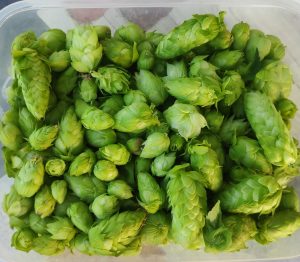
Le Hallertau Blanc a été cultivé pour la première fois en 2012 (région de Hallertau en Allemagne). Ce houblon à l’arôme fruité, aux propriétés vinicoles de groseille et de notes herbacées, est comparable à celui du cépage Sauvignon Blanc. Il présente également un profil aromatique complexe avec des notes de cassis et de fleur de sureau, en plus du raisin, du pamplemousse et de la citronnelle. D’autres notes que l’on peut découvrir lors de la dégustation sont le fruit de la passion et l’ananas. Un très joli houblon pour parfumer une bière de Saison.
Cette première année nous avons déjà pu récolter beaucoup de houblon. Le houblon fraîchement cueilli doit être séché le plus rapidement possible afin que la lupuline (l’agent aromatisant pour lequel le houblon est cultivé) conserve un maximum d’arômes. Nous faisons cela pendant quatre heures à 45°C dans un déshydrateur alimentaire. Le houblon frais contient environ 70 à 80 % d’eau. Cela signifie que vous aimez 100 gr. houblon frais environ 20 à 25 gr. il reste du houblon séché. Finalement nous avons obtenu 400 gr. de houblon pour embaler sous vide et nous le stockons désormais au congélateur. Ceci en prévision du moment où ils finiront comme houblons aromatiques dans l’un des prochains brassins.
This year we planted our own hops for the first time. Six hop plants were expertly planted in the spring. We chose the varieties Mandarina Bavaria, Cascade and Hallertau Blanc.
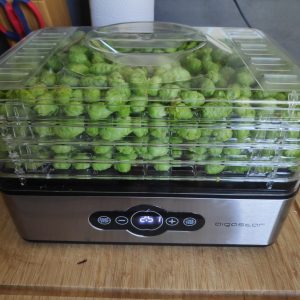
Cascade was released in 1972. It is the most used hop in the American Craft beer world. With its aromas of pine, citrus and floral undertones, it gives the brew life and personality. With a moderate alpha level (determining the bitterness), this hop can be used in versatility, so both as an aroma hop but also as a bittering hop.
Mandarina Bavaria is known since 2012 from a cross of Cascade and Hüll. It’s characterized by an aroma (as the name suggests) of sweet orange-citrus flavor reminiscent of mandarins and clementines. Aromatic with a modest bitterness, Mandarina Bavaria hops can be used as a single hop (as I usually do), or add fine orange citrus notes to hop blends.
Hallertau Blanc was first grown in 2012 (Hallertau region in Germany). This fruity aroma hop, with wine-like properties of gooseberry and grassy notes, is comparable to that of the wine grape Sauvignon Blanc. It also has a complex aroma profile with notes of cassis and elderflower, in addition to grapes, grapefruit and lemongrass. Other notes that can be discovered during the tasting are passion fruit and pineapple. A very nice hop to flavor a Saison beer.
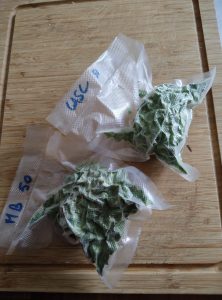
This first year we have already been able to harvest a lot of hops. The freshly picked hops must be dried as quickly as possible so that the lupulin (the flavoring agent for which hops are grown) retains maximum aroma. We do this for four hours at 45°C in a food dehydrator. Fresh hops contain approximately 70 to 80% water. This means you like 100 gr. fresh hops about 20 to 25 gr. dried hops left. In the end we got 400 gr. hops can be vacuum packed and we now store them in the freezer. This in anticipation of the moment that they end up as aroma hops in one of the next brews.
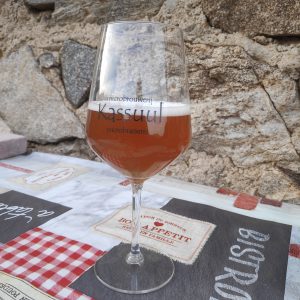
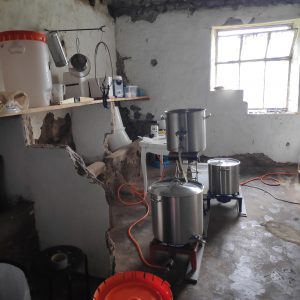
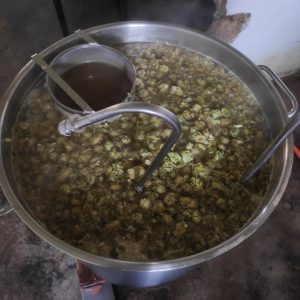
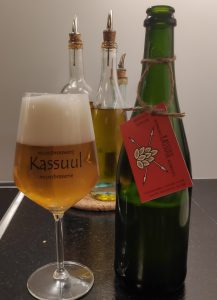 een ‘traditionele’ moutsamenstelling gebruiken (Pilsmout aangevuld met Cara- en speltmout). Voor het maisschema kiezen we voor droger bier en zorgen voor veel korte suikers (beta-amylase) tijdens de latere vergisting. De hoparoma’s worden geleverd door de Nelson Sauvin waarbij een flinke portie in de kookketel gaat bij einde kook op 80°C. En dat is ook op hetzelfde ogenblik dat de druivensap (2 liter druivensap van eigen kweek, zongerijpt in de Ardèche) erbij gaat om zo mee te vergisten. Het bier werd uiteindelijk gebotteld bij 1001 SG (de Saison gist knabbelde zo goed als alle suikers op). En ja, na rijpen op de fles kwam er een heel lekker bier in het glas 😊, met een fijne toets van witte druif (Sauvignon?), mooie volmondige bitterheid die niet bleef ‘kleven’ maar wel goesting deed krijgen naar een tweede glas 😋. En zo hoort het toch, of niet?
een ‘traditionele’ moutsamenstelling gebruiken (Pilsmout aangevuld met Cara- en speltmout). Voor het maisschema kiezen we voor droger bier en zorgen voor veel korte suikers (beta-amylase) tijdens de latere vergisting. De hoparoma’s worden geleverd door de Nelson Sauvin waarbij een flinke portie in de kookketel gaat bij einde kook op 80°C. En dat is ook op hetzelfde ogenblik dat de druivensap (2 liter druivensap van eigen kweek, zongerijpt in de Ardèche) erbij gaat om zo mee te vergisten. Het bier werd uiteindelijk gebotteld bij 1001 SG (de Saison gist knabbelde zo goed als alle suikers op). En ja, na rijpen op de fles kwam er een heel lekker bier in het glas 😊, met een fijne toets van witte druif (Sauvignon?), mooie volmondige bitterheid die niet bleef ‘kleven’ maar wel goesting deed krijgen naar een tweede glas 😋. En zo hoort het toch, of niet?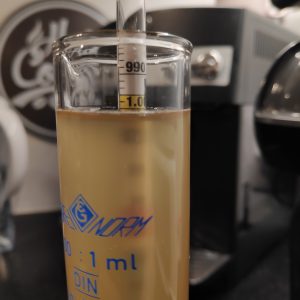 Nelson Sauvin, dont une grande partie passe dans la marmite en fin d’ébullition à 80°C. Et c’est aussi en même temps que le jus de raisin (2 litres de jus de raisin de notre propre culture, mûri au soleil en Ardèche) est mis en fermentation. La bière a finalement été embouteillée à 1001 SG (la levure Saison a grignoté presque tous les sucres). Et oui, après maturation en bouteille, il y avait une très belle bière dans notre verre 😊, avec une fine touche de raisin blanc (Sauvignon ?) , une belle amertume corsée qui ne “collait” pas mais qui donnait envie d’un second verre 😋. Et c’est comme ça que ça devrait être, n’est-ce pas ?
Nelson Sauvin, dont une grande partie passe dans la marmite en fin d’ébullition à 80°C. Et c’est aussi en même temps que le jus de raisin (2 litres de jus de raisin de notre propre culture, mûri au soleil en Ardèche) est mis en fermentation. La bière a finalement été embouteillée à 1001 SG (la levure Saison a grignoté presque tous les sucres). Et oui, après maturation en bouteille, il y avait une très belle bière dans notre verre 😊, avec une fine touche de raisin blanc (Sauvignon ?) , une belle amertume corsée qui ne “collait” pas mais qui donnait envie d’un second verre 😋. Et c’est comme ça que ça devrait être, n’est-ce pas ?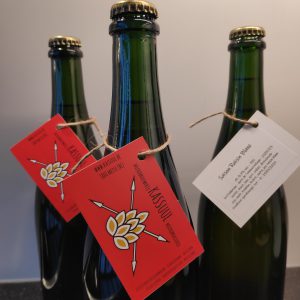 add a lot of short sugars (beta-amylase) during the subsequent fermentation. The hop aromas are provided by the Nelson Sauvin, a large part of which passes into the pot at the end of the boil at 80°C. And it is also at the same time that the grape juice (2 liters of grape juice from our own cultivation, ripened in the sun in the Ardèche) is fermented. The beer was finally bottled at 1001 SG (the Saison yeast nibbled away almost all of the sugar). And yes, after maturation in the bottle, there was a very nice beer in our glass 😊, with a fine touch of white grapes (Sauvignon?), a nice full-bodied bitterness that didn’t “stick” but that made you want a second glass 😋. And that’s how it should be, isn’t it?
add a lot of short sugars (beta-amylase) during the subsequent fermentation. The hop aromas are provided by the Nelson Sauvin, a large part of which passes into the pot at the end of the boil at 80°C. And it is also at the same time that the grape juice (2 liters of grape juice from our own cultivation, ripened in the sun in the Ardèche) is fermented. The beer was finally bottled at 1001 SG (the Saison yeast nibbled away almost all of the sugar). And yes, after maturation in the bottle, there was a very nice beer in our glass 😊, with a fine touch of white grapes (Sauvignon?), a nice full-bodied bitterness that didn’t “stick” but that made you want a second glass 😋. And that’s how it should be, isn’t it?